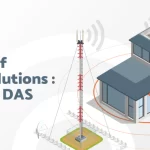Types of DAS Solutions : Active DAS
Distributed antenna systems (DAS) have become a critical part for both enterprise infrastructure and carrier cellular networks. Although, the advantages of passive DAS solutions are noteworthy, as it is considered the simplest approach in terms of design, deployment, and cost-effectiveness. In this blog, we will analyze active DAS and how they are used today.
Active DAS Solution
Active DAS systems convert the analog RF signal from the signal source to a digital signal for distribution using a master unit or “head-end” that combines signals from multiple carriers, which each needs to provide their signal source to the system performing this analog-to-digital conversion.
After the conversion, this digital signal is often transmitted via fiber optic cables to distribute signals between the centralized signal source and the antenna systems (remote nodes) that are placed around a building.
The big inconvenience of active DAS is that the equipment used isn’t cheap, meaning an upgrade path for fully active DAS can be expensive because it involves the replacement or installation of active equipment for each antenna location.Generally, active DAS systems are typically used when additional capacity is needed, a good example would be a football stadium or airport.
The other main drawback is that every installation must be approved by the affected cell phone carriers. This is an FCC regulation because the carriers own the cellular frequencies and the carrier approval is granted, however, the logistics can be complex.
The advantages of active DAS solutions are remarkable as fiber optic cable installations are far less intense than coaxial cables installations. There is also a lower degree of complexity without coaxial cables being terminated and tested. In general, the overall project cost may be lower than other options, even if the cost of parts and materials are higher. Active DAS can be monitored remotely to the antenna, which allows easier diagnosis of any issues as they occur.
Click here to contact us and learn more about how Peer Communications can help your organization integrate effective and cost-effective Active DAS systems





